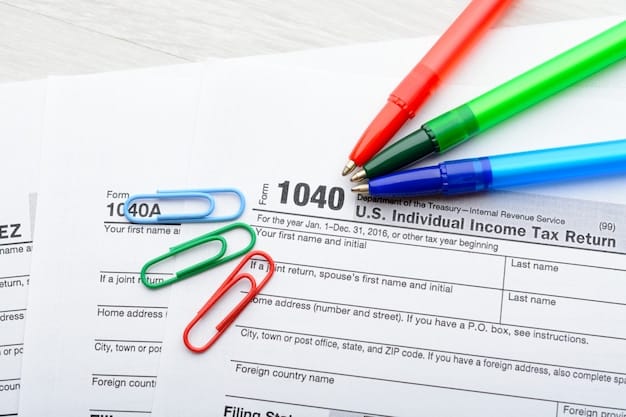IRS $600 Gig Worker Threshold: How it Impacts Your 2025 Taxes

The new IRS gig worker reporting threshold of $600 significantly impacts your 2025 taxes by requiring platforms to report income exceeding this amount, potentially increasing tax obligations and necessitating careful income tracking.
Navigating the gig economy just got a bit more complex. Understanding how the new IRS gig worker reporting threshold of $600 impacts your 2025 taxes is crucial for avoiding unwelcome surprises and ensuring compliance.
Understanding the New $600 Reporting Threshold
The IRS has implemented a significant change regarding the reporting of income earned through gig work. This new threshold impacts a large number of individuals who participate in the gig economy, requiring platforms to report earnings more comprehensively.
What Exactly is the $600 Reporting Threshold?
Previously, platforms like Uber, Airbnb, and Etsy only had to issue a 1099-K form if a worker earned over $20,000 and had more than 200 transactions. The new threshold dramatically lowers this requirement, meaning many more individuals will receive these forms.
Why Did the IRS Change the Reporting Threshold?
The IRS aims to improve tax compliance by increasing visibility into income earned through gig work. They believe that many individuals were underreporting this income, leading to a significant tax gap. The lower threshold is designed to capture a more accurate picture of earnings across the gig economy.

Understanding this change is vital. Here are some key points to keep in mind:
- The new threshold applies to income earned through various platforms, encompassing ridesharing, freelancing, online sales, and more.
- Platforms are now required to issue a 1099-K form to anyone earning $600 or more within a tax year.
- This change affects your 2025 taxes, as it applies to income earned in the 2024 tax year.
In summary, the lowered reporting threshold aims to enhance tax compliance within the gig economy by requiring platforms to report earnings exceeding $600, which impacts a significant number of gig workers and necessitates a comprehensive understanding of these changes for accurate tax reporting.
Who is Affected by the $600 IRS Gig Worker Reporting Threshold?
The new $600 reporting threshold affects a broad range of individuals participating in the gig economy. It’s essential to determine if you fall into this category to prepare adequately for your 2025 taxes.
Gig Workers and Freelancers
Anyone earning income through platforms like Upwork, Fiverr, or TaskRabbit is directly affected. If your earnings across these platforms exceed $600 in a tax year, you’ll receive a 1099-K form, and that income must be reported on your tax return.
Rideshare and Delivery Drivers
Drivers for Uber, Lyft, DoorDash, and similar services are also impacted. Even if you drive part-time, your earnings are subject to the new threshold. Be sure to track all income and expenses related to your driving activities.
This threshold change also impacts:
- Online Sellers: Individuals selling goods on platforms like eBay, Etsy, or Amazon.
- Short-Term Rental Hosts: Those renting out properties through Airbnb or VRBO.
- Independent Contractors: Professionals providing services directly to clients, such as consultants or graphic designers.
Exemptions and Considerations
It’s important to note that the $600 threshold is based on gross income, not net profit. This means even if your profits are lower due to expenses, you’re still required to report the gross amount if it exceeds $600.
Essentially, the new reporting threshold casts a wide net, affecting numerous participants in the gig economy, prompting diligence in income tracking and tax preparation to ensure compliance and accurately reflect earnings in the upcoming tax season.
Understanding Form 1099-K and Its Implications
A key aspect of the new IRS gig worker reporting threshold is understanding Form 1099-K. This form is used to report payments you’ve received from payment card transactions and third-party network transactions.
What Information Does Form 1099-K Include?
Form 1099-K includes your gross payment volume, meaning the total amount of money you received through the platform. It also includes the number of transactions and the payer’s (platform’s) information.
How Will You Receive Form 1099-K?
The platform you’re working through will typically provide Form 1099-K electronically or through the mail by January 31st of the following year. For your 2025 taxes, you’ll receive this form in early 2025.

Consider the following when reviewing your 1099-K:
- Verify the accuracy of the information, including your name, address, and tax identification number.
- Ensure that all transactions listed belong to you and are correctly reported.
- Report any discrepancies to the platform immediately to avoid issues with the IRS.
Implications for Your Tax Return
The income reported on Form 1099-K is considered taxable income and must be included on your tax return. You’ll typically report this income on Schedule C (Profit or Loss from Business) of Form 1040.
In short, grasping the essentials of Form 1099-K and its ramifications is pivotal for gig workers to accurately report income, ensure tax compliance, and reconcile earnings with reported amounts, thereby facilitating a smoother tax filing process.
Strategies for Tracking Gig Economy Income and Expenses
Effectively tracking your gig economy income and expenses is essential for accurate tax reporting and maximizing potential deductions. Establishing robust tracking systems can significantly simplify the tax preparation process.
Utilize Accounting Software or Apps
Several accounting software options are tailored for freelancers and gig workers. Popular choices include QuickBooks Self-Employed, FreshBooks, and Wave Accounting. These tools allow you to easily categorize income and expenses, track mileage, and generate reports.
Maintain Detailed Records
Keep thorough records of all income and expenses. This includes invoices, bank statements, receipts, and any other documentation that supports your financial transactions. Creating a categorized filing system, either digital or physical, can help you stay organized.
Here are some additional tips for effective tracking:
- Open a separate bank account for your gig work to keep your business and personal finances separate.
- Use a mileage tracking app to accurately record business-related travel.
- Regularly reconcile your income and expenses to identify any discrepancies.
Documenting Deductible Expenses
Many expenses related to gig work are tax-deductible. Common deductions include business expenses, home office expenses, car and truck expenses, and more. Documenting these expenses meticulously can help reduce your taxable income.
To summarize, adopting effective strategies for tracking both income and expenses is vital for gig workers to maintain accurate financial records, streamline tax preparation, and optimize deductible expenses, ensuring compliance and potential tax savings.
Tax Deductions and Credits for Gig Workers
One of the significant advantages of being a gig worker is the potential to claim various tax deductions and credits. Understanding these opportunities can help reduce your overall tax liability.
Common Tax Deductions
Gig workers can deduct many business-related expenses, such as the cost of goods sold, advertising expenses, insurance, and professional fees. The key is to ensure that these expenses are ordinary and necessary for your business.
Home Office Deduction
If you use a portion of your home exclusively and regularly for business, you may be eligible for the home office deduction. This deduction can cover expenses like rent or mortgage interest, utilities, and depreciation.
Consider these additional deductions and credits:
- Self-Employment Tax Deduction: You can deduct one-half of your self-employment tax from your gross income.
- Qualified Business Income (QBI) Deduction: Eligible self-employed individuals can deduct up to 20% of their qualified business income.
- Health Insurance Deduction: Self-employed individuals may be able to deduct the amount they paid for health insurance premiums.
Navigating Tax Credits
Tax credits can directly reduce your tax liability, offering a dollar-for-dollar reduction. Explore credits like the Earned Income Tax Credit (EITC) or credits for education expenses, if applicable.
In conclusion, gig workers can significantly benefit from understanding and utilizing available tax deductions and credits, as these opportunities can greatly reduce taxable income and overall tax obligations.
Preparing for the 2025 Tax Season Under the New Rules
As the 2025 tax season approaches, gig workers need to take proactive steps to prepare under the new reporting threshold. Proper preparation is crucial for a smooth and accurate tax filing process.
Gathering Necessary Documents
Collect all relevant tax documents, including Forms 1099-K, receipts for deductible expenses, bank statements, and mileage logs. Having these documents organized in advance will save time and reduce stress.
Reviewing Your Tax Withholdings
Consider reviewing your estimated tax payments to ensure you’re withholding enough to cover your tax liability. If you anticipate a significant increase in income or changes in deductions, adjust your withholdings accordingly.
Key steps to take include:
- Consult with a Tax Professional: A tax professional can provide personalized guidance and ensure you’re taking advantage of all available deductions and credits.
- Use Tax Preparation Software: Tax software like TurboTax or H&R Block can streamline the filing process and help you identify potential deductions.
- Stay Informed: Keep up-to-date with any changes to tax laws and regulations that may affect your gig work.
Understanding Estimated Taxes
Gig workers are generally required to pay estimated taxes on their income throughout the year. These payments are typically made on a quarterly basis and help avoid penalties for underpayment.
Overall, preparing thoroughly for the 2025 tax season under the new reporting threshold is essential for gig workers, involving meticulous document gathering, careful evaluation of tax obligations, and proactive engagement with tax resources to ensure compliance and minimize potential issues.
| Key Point | Brief Description |
|---|---|
| 📝 New $600 Threshold | IRS now requires platforms to report income exceeding $600. |
| 💼 Affected Workers | Includes freelancers, drivers, online sellers, and rental hosts. |
| 📊 Form 1099-K | Platforms provide this form for reported income; verify its accuracy. |
| 🧾 Tax Strategies | Track income, expenses, and utilize available deductions and credits. |
Frequently Asked Questions (FAQ)
▼
The new threshold is $600, meaning platforms must report income if a worker earns $600 or more in a tax year.
▼
The rule affects various gig workers, including freelancers, drivers, online sellers, and short-term rental hosts earning over $600.
▼
Form 1099-K reports payments you received from payment card and third-party network transactions exceeding $600.
▼
Use accounting software, maintain detailed records, and open a separate bank account for gig work.
▼
Common deductions include business expenses, home office expenses, self-employment tax, and health insurance premiums.
Conclusion
Understanding how the new IRS gig worker reporting threshold of $600 impacts your 2025 taxes is vital for anyone participating in the gig economy. By tracking income and expenses diligently, utilizing available deductions and credits, and staying informed about tax regulations, you can ensure a smooth and accurate tax filing process. Always consult with a tax professional for personalized guidance.





